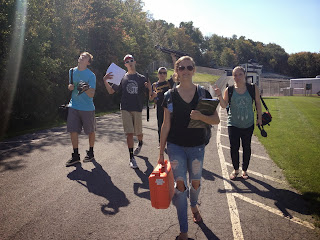My friends and I are entering the Golden Doorknob Awards and I'M SO EXCITED.
A few weeks ago, my friends Dana, Taylor, and I went to see Dave Franco, Chris Mintz-Plasse and the rest of the hilarious bros that make up Funny or Die, speak at Park. They talked about how amazing it is to work on projects with your friends and how they came up with the ideas behind some of their popular videos. Later that week, Dana, Taylor, and I decided to make a film for the Golden Doorknob Awards, a short film contest where the only requirement is that someone or something must be "terminated" by a doorknob.
At first we were thinking of taking a dramatic route, but then we thought back to Dave and Chris's popular Funny or Die videos. It was the dark humor and "homo-eroticism" (as they called it) that made them so funny. Inspired by their videos, the idea behind our short film started to unfold. And so we came up with this plot for our video:
Jason is a teenager struggling with
narcolepsy, and his form of narcolepsy is triggered by sexual arousal—every
time he gets turned, he falls asleep. This short film shows him in middle
school, high school, and ultimately college, where he meets his inevitable
death. His best friend, Sean, knows about his issue and he does not care that
he falls asleep all the time. In fact, Sean is gay for Jason; however, Jason is
oblivious to this.
Jason’s narcolepsy gets so bad that
he eventually takes medication for it. Before a party one night in college,
Jason is determined to not let his medical disability get in the way of him
having a good time. One thing leads to another, and Jason’s friend, Ali, leaves
the party with him. The two are passionately kissing when Ali pins him against
his dorm room door, but at that moment, he falls asleep, hits his head on the
doorknob, and dies. (C)STD Productions
I'm a co-producer, co-writer, and co-director for the film, but I was also the person in charge of audio. In my Intro to Audio class I'm learning just how important sound is in a film. Music has the ability to move people: make them laugh or cry. Without sound, a movie wouldn't be as funny, sad, dramatic, or happy.
Therefore, I took my job VERY seriously. Lugging all my equipment from PPECS to the towers and back. Yelling at people on set because I didn't want to take my headphones off. Carefully editing the songs we would use in the film. Always carrying around extra double A batteries and SD cards, just in case my Zoom died or I ran out of space on the memory card I was using. I kept a sound log, so all my recordings were organized. And I listened to everything. Listening to the world through a stereo microphone and circumaural headphones allows you to hear things that you wouldn't notice otherwise.


















































